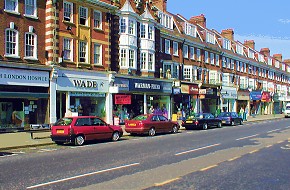|
|
 |
|
Barnet
|
 |
|
Created by American property developers at the beginning of the twentieth century, Golders Green is particularly renowned
as a home of London’s middle class Jewish community. The name probably derives from a fourteenth century resident called
Godyere. A number of ‘ornamental villas’ appeared from the late eighteenth century and the crossroads that forms
the hub of Golders Green was created by the arrival of the Finchley Road in the late 1820s. The London County Council’s
acquisition of Golders Hill House and its gardens in 1898 brought the first public park to the urban district of Hendon. This
was followed by rapid suburban development of the neighbourhood and Golders Green’s first shopping parade was established
in 1908. The Golders Green Hippodrome opened in 1913. It has served as a music hall, cinema and theatre and is now a BBC recording
studio. After the First World War, a large number of Jewish families began moving into the new housing from the crowded East
End and synagogues were built to serve the community. Immigrant Jews fleeing Nazi persecution augmented the settlement during
the 1930s. At the same time, the builders Laing laid out the racetrack-shaped Golders Green estate in the south-west corner
of the district. Cricklewood Aerodrome had occupied the site from 1916 to 1930. The 1930s also saw the erection of mansion
blocks in central Golders Green. The visible signs of Golders Green’s Jewish character are diminishing as new communities,
especially Korean and Japanese, have been moving in.
|
 |
|
|
|
 |

|
| The shops on Golders Green Road lack the Jewish character that distinguished them a few years ago |
The London Cremation Company opened the city’s first crematorium on Hoop Lane in 1902. Among those cremated here have been Sigmund Freud, Neville
Chamberlain, Bram Stoker, Marie Stopes, Ivor Novello and Anna Pavlova.
Badfinger – one of the most successful bands signed to the Beatles’ Apple label – recorded in their studio in Golders
Green. After the suicide of singer/songwriter Pete Ham albums of his demo tapes were released, entitled 7 Park Avenue and Golders Green.
|
 |
|
|
|
|
|
Postal district: NW11
Population: 16,249
Station: Northern Line (Zone 3)
Further reading: Clive R Smith, Golders Green as It Was, CR Smith Publications, 1998

Text and selected images are reproduced with the permission
of Chambers but may differ from the published versions
All content © 2005–2010
|
|
|
 |

